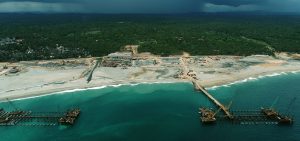India’s ambitions of emerging an Indian Ocean transshipment hub received a boost on October 15 when Vizhinjam International Seaport near Thiruvananthapuram in the southern state of Kerala welcomed its first ship, the Hong Kong-flagged Zhen Hua 15 carrying cranes from Shanghai for the port site.
Vizhinjam Port is India’s first deepwater container transshipment port. It has a natural draft of 18-20 meters, which means that some of the largest container vessels in the world will be able to dock here. Port officials say that Vizhinjam Port will be able to handle container vessels with 24,000 twenty-foot equivalent units (TEU) capacity and more.
Importantly, Vizhinjam is located around 10 nautical miles from the international shipping route connecting Europe and the Persian Gulf with East Asia through which around 30 percent of global maritime cargo passes.
Fully owned by the Kerala government, Vizhinjam Port is being built by Adani Vizhinjam Ports Private Ltd, a subsidiary of Adani Ports and SEZ Ltd (APSEZ), India’s largest private sector port operator.
The port is expected to be fully operational by May 2024. It will have a capacity of 1 million TEUs in phase 1 and another 6.2 million TEUs will be added in subsequent phases.
India has a 7,500-kilometer-long coastline. Although around 200 major and minor ports dot this coastline, the country’s port infrastructure is dismal. Not one of these ports figures in the world’s top 30 ports.
Besides, most Indian ports have a shallow draft. This means that vessels with large tonnage, increasingly the norm in international maritime trade today, cannot dock at Indian ports.
Consequently, large container vessels with consignment meant for India must offload at nearby transshipment ports where the cargo is then loaded onto smaller feeder ships that can dock at Indian ports.
Ships with cargo headed to India have therefore had to dock at transshipment ports at Colombo in Sri Lanka, Jebel Ali in Dubai, Klang in Malaysia, and Singapore Port instead of Indian ports. India has been heavily dependent on these foreign ports for transshipment of cargo.
Currently, nearly 75 percent of India’s transhipped cargo is handled at foreign ports, with Colombo, Singapore and Klang ports handling over 85 percent of this cargo. Colombo Port alone handles 45 percent of India’s transshipped consignments.
“Vizhinjam port is expected to change this. It will have the capacity to cater to 75 percent of India’s container transshipment needs,” an official at India’s Ministry of Shipping and Ports told The Diplomat. This will save India “a large amount of foreign exchange that it has been paying to foreign ports to meet its transshipment needs.” Additionally, “we are expecting a slice of the transshipment business currently going to Dubai, Sri Lanka and Singapore to come to India,” the official said.
North of Vizhinjam port is another container transshipment terminal at Vallarpadam at Kochi also in Kerala, which is operated by Dubai Ports World.
A third transshipment port is being developed at Galathea Bay in the Great Nicobar island of the Andaman and Nicobar Islands. With a natural depth of 20 meters, Galathea Bay like Vizhinjam can accommodate large container vessels. Located some 40 nautical miles from the East-West shipping route and lying outside the crowded Malacca Strait, the port at Galathea Bay will be hoping to attract large container ships with freight headed to countries like Bangladesh and Myanmar among others that have been using ports in Singapore and Malaysia.
So, what are the chances of the transshipment ports propelling India into a major Indian Ocean transshipment hub?
The fate of Vallarpadam Port does not bode well. Over a decade after the port began operations, it is still functioning way below capacity. Besides, it never transformed itself into a transshipment terminal; just 6 percent of the containers handled by the port in 2020 were transshipment containers. A major part of Vallarpadam’s problem is that its natural draft is just 14.5 meters, which means it cannot accommodate large container ships. It needs to be dredged regularly which adds to the costs of operating the port.
Some have pointed out that the three Indian transshipment ports in such proximity — Vizhinjam port is about 180 nautical miles from Vallarpadam port — will make it difficult for them to attract enough business.
Jose Paul, former acting chairman of the Jawaharlal Nehru Port at Mumbai, and former chairman of the Mormugao Port Trust in Goa draws attention to ports that are located close to each other and thrive. “Port Klang and Port of Tanjung Pelepas in Malaysia co-exist within a distance of about 150 nautical miles, Jebel Ali and Abu Dhabi in the UAE are within 81 nautical miles, and Tacoma and Seattle in the US are within 33 nautical miles,” he told Rediff news portal. Likewise, “Vallarpadam and Vizhinjam can coexist because Vallarpadam can only accommodate container ships up to a maximum of 10,000 TEU capacity while Vizhinjam can accommodate even the ultra large container ships with capacity ranging from 10,000 to 25,000 TEUs or even more.”
In other words, “these two ports can complement and supplement each other in their respective segments and there need not be any rivalry between” them.
While Vizhinjam’s natural endowments i.e., its deep draft and location make it an attractive transshipment option, this alone will not be enough to draw the fiercely competitive shipping business. “Competitive pricing and turnaround time are critical to attracting shipping traffic, the shipping ministry official said. Additionally, overland connectivity infrastructure, including roads and railway links, need to be improved.

































